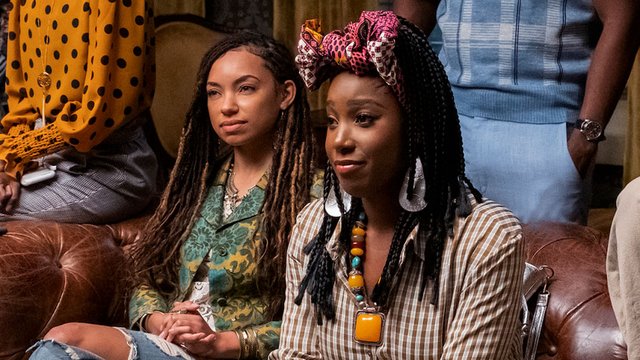DEAR WHITE PEOPLE SEASON III - REVIEW TV - SCALE 09/10
The third season, however, with the absence of a clear conductive thread, lowers its level a few points and leaves us wondering if the urgent message was more relevant than what was built over two bright seasons.

Source
First part
Justin Simien, creator of the series and probably "Lionel", is a kind of Sam Esmail (the creator of Mr. Robot) for Dear White People. Omnipresent in the script and in much of the direction (and photography that is superlative), he handles with great skill what he wants to do with the characters he created for a movie and ended up extrapolating to a series. Each is, in part, an exaggerated (and of course, in cases, burlesque) and contemporary ideological side of the United States. UU.
In the last chapter of the season it becomes clear to us that Simien's ideological position, to vary with Yankee series writers, is closer to nihilism than to what it seemed to propose in previous seasons. It shows that it is still complex to play it in full and perhaps that path is the one that American society is more willing to accept. It happens in Mr. Robot (I did not make the comparison for anything), it happens in The Simpsons, and even in Rick & Morty or even in 13 Reasons Why or the excellent The Society.

Source
Second part
Those who challenge the system by proposing a completely different one are almost always shown as obsessive, loud and intense characters to the point of being insufferable to the rest. And it is what happens moderately in the plot line of Gabe, which is one of the most interesting of the series (although not the one that generates more intrigue).
The third season starts after where we had left the immense cliffhanger of the second. Sam and Lionel are in the bell tower with the representative of Order X, the club? Winchester's secret. The man seems to rave in the eyes of the duo, who in five minutes get rid of it and throw overboard, at least momentarily, all the hype built based on this plot.

Source
In a joke that they repeat twice in the same chapter, "it seems that we were in the third season of a Netflix series", the protagonists suggest that in this section of the series they will put the Falcon in CNG. And that is what happens. The black community of Winchester faces disintegration because everyone - and especially the leaders of the movement - is quite in their own. Troy allied with the stale whites of "Pastiche", the university's humorous magazine. Sam with his documentary thesis. And Reggie helping his hero, Professor Moses Brown (Blair Underwood) with the development of an app. Brown's character is the most exciting part of the series because he is the one who proposes a very complex ideological maze to his students. A leftist teacher, who supports his students and encourages them to organize and act but has been accused of propating with a student. This debate is not finished and is not the only disturbing thing about Brown, who seems to be part of Order X.

Source
Third part
The different plots converge in some sector, being Joelle and Coco's - which is a great character and should not be neglected - the weakest and most mundane conflicts but no less interesting. However, they are the ones that seem to suffer most from the lack of a clear thread, so their plots occur by proximity to other characters (Muffy and Reggie). It ends up being a negative byproduct that drags from previous seasons where each chapter focused on a single character, a trend that was eliminated in this season although each episode has somehow a reference.
I repeat, each character is quite in his and there is no obvious conflict, but several that are interspersed. It doesn't seem well managed.
Mad Men, less clear from the ideological (or clear zero), has managed to coordinate the plots in a common diffuse point since the beginning of each season because despite the choral style, it has a protagonist far above the rest. Dear White People, whose supposed exclusive protagonist is Sam, preferred a path with more bifurcations and, at least this season, affected the narrative quite a bit.

Source
Personal Review
For the nerves of the “cinematography” it is possible to find the shot per episode where the DF gives us a set made with a “split diopter” (look for Twitter ‘split diopter alert’). It is not the only cinematographic resource that is used throughout the series. On the contrary, at times, and I imagine that by the way, the series seems filmed by movie students trying to throw all possible tricks on the court. But it goes well, and is very entertaining to see and discover.
The third season of Dear White People loses a little direction, more than anything in its equator like many other Netflix series, and yet, it is great and superior to enough of what there is to see anywhere else. Maybe they are venturing, looking for where to run aground.
Congratulations @very86! You have completed the following achievement on the Steem blockchain and have been rewarded with new badge(s) :
You can view your badges on your Steem Board and compare to others on the Steem Ranking
If you no longer want to receive notifications, reply to this comment with the word
STOPTo support your work, I also upvoted your post!
Vote for @Steemitboard as a witness to get one more award and increased upvotes!
Seems great movie to add in watch list with that rating.
Thanks for your contribution.
Regards,
@anggreklestari
[RealityHubs Curator]
Hey there @very86! This is a really great review of the TV series. The drama and dynamics you described tells me this is a series I would absolutely enjoy watching. Thank you for using the #realityhubs tag. I will be looking forward to your next review.
RealityHubs Mod